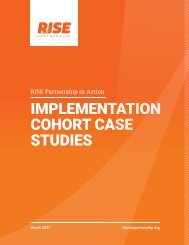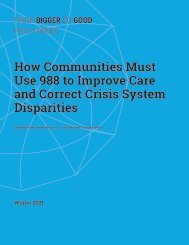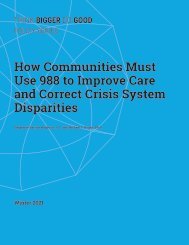Scattergood_Establishing Sanctioned Safe Consumption Sites in the United States_Web
Create successful ePaper yourself
Turn your PDF publications into a flip-book with our unique Google optimized e-Paper software.
Exhibit 1 Level of Government Targeted to Advance SCS Policy<br />
City or<br />
County<br />
Description of Approach<br />
All five jurisdictions were pursu<strong>in</strong>g local<br />
government policy mechanisms to establish<br />
SCSs (e.g., health department approval,<br />
emergency declaration, city ord<strong>in</strong>ance). Two<br />
jurisdictions focused exclusively on policy<br />
mechanisms available at <strong>the</strong> city/county level<br />
because state government level support was not<br />
feasible. Both had executive branch support (i.e.,<br />
mayor, health department). One jurisdiction’s city<br />
council had allocated fund<strong>in</strong>g for an SCS.<br />
Quotations Expla<strong>in</strong><strong>in</strong>g Approach<br />
“We advocated not to do [state legislation] because we knew<br />
that it couldn’t pass <strong>the</strong> legislature because of split control.<br />
. . . [There was] concern that hav<strong>in</strong>g a bill fail can create <strong>the</strong><br />
impression that without that bill, you can’t do it, but that’s<br />
not true. The public health department can do it without <strong>the</strong><br />
bill so we were afraid of detrimental effects from a failed<br />
bill.”<br />
“The mayor could declare a public health emergency. This is<br />
how <strong>the</strong>y established syr<strong>in</strong>ge services. Ano<strong>the</strong>r mechanism<br />
could be an ord<strong>in</strong>ance from <strong>the</strong> city council that would be<br />
renewed <strong>in</strong> perpetuity.”<br />
State<br />
Legislation<br />
Description of Approach<br />
In three of <strong>the</strong> five jurisdictions, state legislators<br />
had <strong>in</strong>troduced bills authoriz<strong>in</strong>g SCSs. None had<br />
passed at <strong>the</strong> time of this study, but sponsors<br />
were plann<strong>in</strong>g to re-<strong>in</strong>troduce bills <strong>in</strong> subsequent<br />
legislative sessions. Participants from <strong>the</strong> two<br />
jurisdictions <strong>in</strong> states that had not <strong>in</strong>troduced<br />
legislation authoriz<strong>in</strong>g SCSs opted not to do so<br />
given <strong>the</strong> political composition of <strong>the</strong>ir state<br />
legislatures.<br />
Quotations Expla<strong>in</strong><strong>in</strong>g Approach<br />
“In [X state], <strong>the</strong> long game is to get legislation passed . . . if it<br />
passes, it will be a game changer on this issue for <strong>the</strong> state<br />
and <strong>the</strong> country.”<br />
“We could have <strong>in</strong>troduced <strong>the</strong> [state] legislative package<br />
and tried to build movement <strong>in</strong> [X city], but I don’t th<strong>in</strong>k<br />
[X city] is conducive to that. . . . [O<strong>the</strong>r cities plann<strong>in</strong>g to<br />
implement SCS] are <strong>the</strong> biggest tax generators <strong>in</strong> <strong>the</strong>ir state.<br />
. . . [X city] can’t do its own th<strong>in</strong>g <strong>in</strong> <strong>the</strong> same way that those<br />
[jurisdictions] can.”<br />
Multiple<br />
pathways<br />
Description of Approach<br />
In <strong>the</strong> three jurisdictions pursu<strong>in</strong>g state<br />
legislation, <strong>the</strong> state legislation was part of a<br />
broader strategy that <strong>in</strong>volved pursu<strong>in</strong>g locallevel<br />
policy change as well. Advocates <strong>in</strong> one<br />
jurisdiction also were work<strong>in</strong>g to push <strong>the</strong> state<br />
executive branch (i.e., governor and state health<br />
department) to authorize SCS adoption as pilot<br />
research.<br />
Quotations Expla<strong>in</strong><strong>in</strong>g Approach<br />
“[T]he legislative push is support<strong>in</strong>g <strong>the</strong> [research] pilot<br />
push. . . . In our m<strong>in</strong>d, of course we want to pass legislation.<br />
The legislation supports <strong>the</strong> pilot efforts and <strong>the</strong> pilot efforts<br />
support <strong>the</strong> legislation.”<br />
“[There is a] whole o<strong>the</strong>r conversation to be had about<br />
<strong>the</strong> state legislation we’re runn<strong>in</strong>g—a state bill to create<br />
authorization for <strong>the</strong> city to create [SCSs] and protect <strong>the</strong> city<br />
from state law.”<br />
Bracketed text <strong>in</strong>dicates edit<strong>in</strong>g by <strong>the</strong> authors ei<strong>the</strong>r to clarify <strong>the</strong> context of <strong>the</strong> quotation or to substitute potentially identify<strong>in</strong>g <strong>in</strong>formation with more generic language.

















